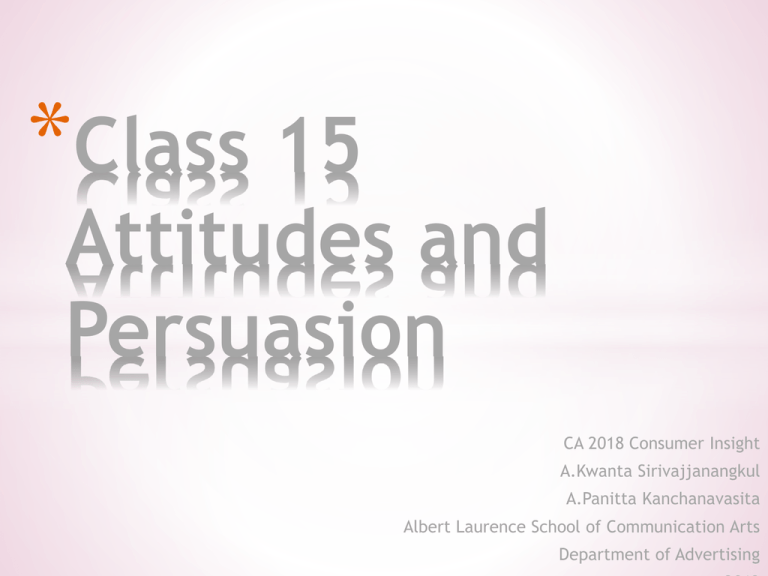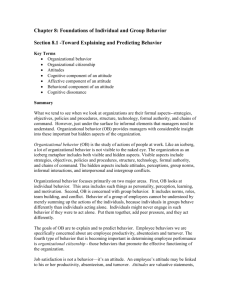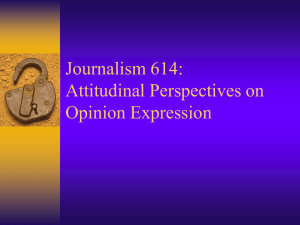CA2018 Attitude - Department of Advertising, Albert Laurence
advertisement

*Class 15 Attitudes and Persuasion CA 2018 Consumer Insight A.Kwanta Sirivajjanangkul A.Panitta Kanchanavasita Albert Laurence School of Communication Arts Department of Advertising * *The Power of Attitudes *The ABC Model of Attitudes *Hierarchies of Effects *How Do We Form Attitudes? *The Consistency Principle *Self-Perception Theory *Social Judgment Theory *How Do Marketers Change Attitudes? 1 * * 1 *Attitude is a lasting, general evaluation of people (including oneself), objects, advertisements, or issues. *We call anything toward which one has an attitude an attitude object. *An attitude is lasting because it tends to endure over time. *An attitude is general because it applies to more than a momentary event 1 * *Psychologist Daniel Katz developed the functional theory of attitudes to explain how attitudes facilitate social behavior. *According to this pragmatic approach, attitudes exist because they serve some function for the person *Two people can each have an attitude toward object for very different reasons 1 * * Utilitarian function: * Pleasure or pain, delicious or not delicious * Value-expressive function * What product says about him as a person * Ego-defensive function * We form attitudes to protect ourselves either from external threats or internal feelings * Knowledge function * We need order, structure, or meaning * Only when a person is in ambiguous situation 2 * 2 * Affect How a consumer feels About an attitude object Behavior Intentions to take action about it Cognition What he believes to be true about the attitude object *** interrelationships among knowing, feeling, and doing 3 * 3 * • Which comes first: Knowing, feeling, or doing? • Each element may lead things off depending on the situation • Hierarchies of Effects explain the relative impact of the three components Feeling Affect Doing Behavior Knowing Cognition 3 * Knowing Cognition Feeling Affect Doing Behavior Attitude Based on cognitive information processing • Think Feel Do • A person approaches a product decision as a problem-solving process 3 * Doing Behavior Feeling Affect Knowing Cognition Attitude Based on behavioral learning processes • Do Feel Think • The consumer initially doesn’t have a strong preference for one brand over another • The consumer forms an evaluation only after they have bought the product • The attitude is to come through behavioral learning 3 * Feeling Affect Doing Behavior Knowing Cognition Attitude Based on hedonic consumption • Feel Think Do • The consumers act on the basis of emotional reactions, hedonic motivations • Intangible product attributes such as package design, advertising, And Brand names 4 * 4 * * We all have lots of attitudes * We are not born with the conviction * Ex. Pepsi is better than Coke * We forms attitude in several different ways, depending on the particular hierarchy of effects that operates * Ex. As in Chapter 3,attitude toward a brand due to classical conditioning – Pepsi name + a catchy jingle (you are in Pepsi generation) * Ex. Due to instrumental conditioning – you take a swig of Pepsi and it quenches your thirst 4 * Commitment to an attitude; the degree of commitment relates to the level of involvement with the attitude object 4 * THREE (increasing) levels of commitment: 1. Compliance * the lowest involvement, superficial – easy to change * We form an attitude because it helps us to gain rewards or avoid punishment 2. Identification * We form an attitude to conform to another person’s or group’s expectations * Imitating the behavior of desirable models 3. Internalization * The high level of involvement, deep seated attitudes, value system * Very difficult to change because they are so important 5 * 5 * *Why does a need to maintain consistency among all of our attitudinal components motivate us to alter one or more of them? 5 “Pepsi is my favorite soft drink. It tastes terrible” 5 “I love my boyfriend. He is the biggest idiot I have ever met” 5 * Principle of Cognitive Consistency *Harmony among thoughts, feelings, and behaviors and a need to maintain uniformity among these elements *We change our thoughts, feelings, or behaviors to make them consistent with other experiences *A big factor is how well they fit with other related attitudes we already hold 5 * Theory of Cognitive Dissonance *When a person is confronted with inconsistencies among attitudes or behaviors, he will take some action to resolve this “dissonance” *He perhaps change his attitude or modify his behavior to restore consistency *Ex. Conflict between attitudes toward a product or service and what we actually do or buy *Postpurchase Dissonance: consumers tend to find reasons to support for their decisions 5 * * Do we always change our attitudes to be in line with our behavior because we are motivated to reduce cognitive dissonance? * Observing our own behavior to determine just what our attitudes are 5 * *The initial attitude acts as a frame of reference *We categorize new information in terms of this existing standard 6 * 6 * * Persuasion – an active attempt to change attitudes * Basic psychological principles that influence people to change their minds or comply with a request; 1. 2. Reciprocity – We are more likely to give if first we receive 3. Authority – Authoritative source is much more readily than less authoritative one 4. Consistency – people try not to contradict themselves in terms of what they do or say about that issue 5. Liking – we agree with those we like or admire Scarcity – Like people, items are more attractive when they are not available *Any Questions










